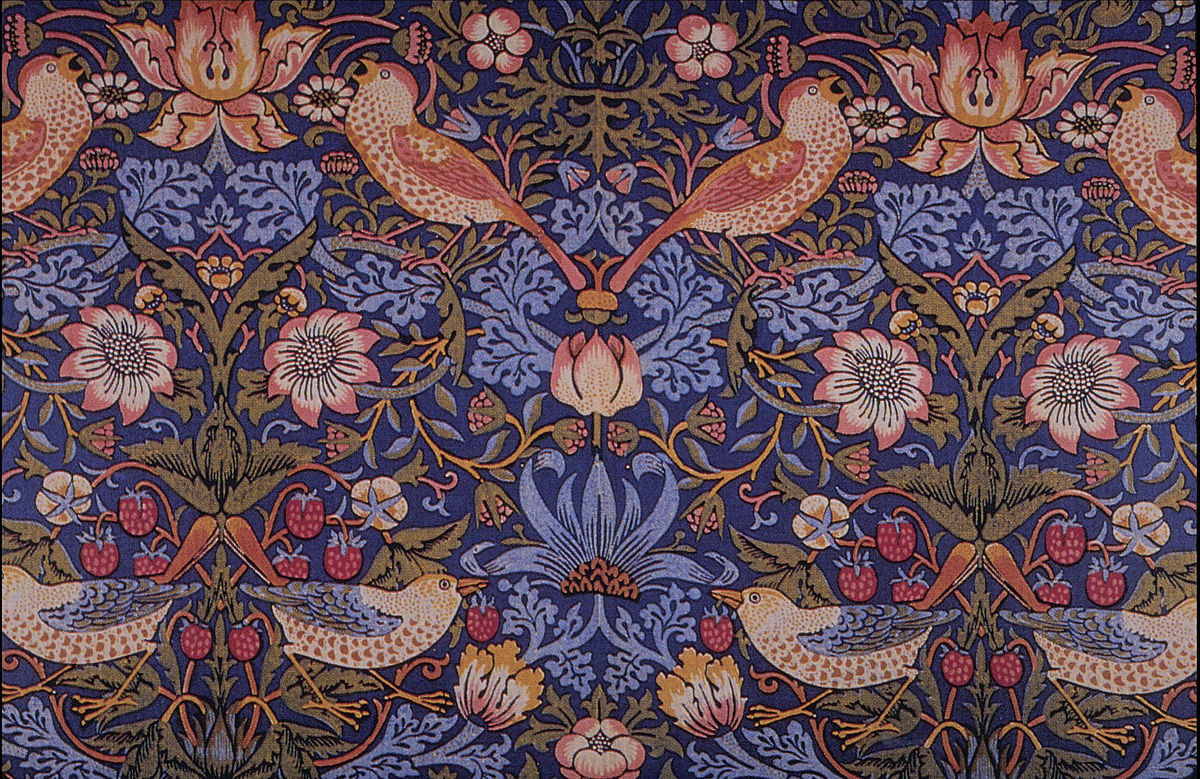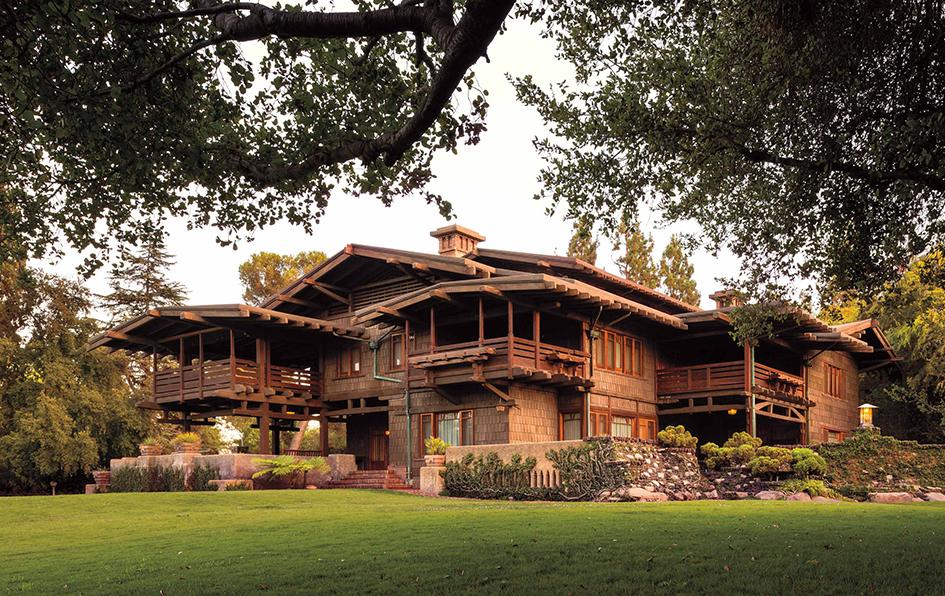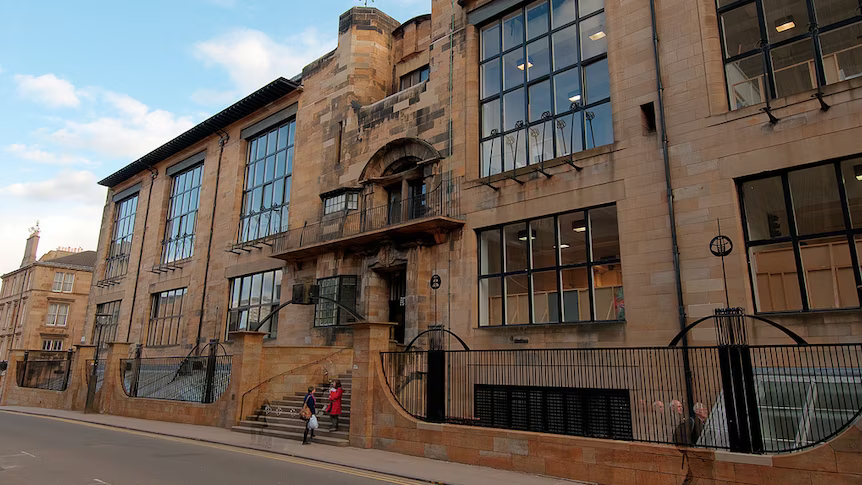 |
||||
|
The Arts and Crafts MovementBy Chaz G. T. Patto - June 2023.
INTRODUCTION
Right: William Morris - The Strawberry Thief - 1883. The Arts and Crafts movement was a major art and design movement that emerged in Britain in the mid-19th century and spread to other parts of Europe and North America. It was a reaction against the industrialization and mass production of the time, and sought to revive traditional craftsmanship and promote the beauty of handmade objects. The movement's founders, including William Morris and John Ruskin, believed that art should be integrated into daily life and that the beauty of everyday objects could enrich people's lives. They emphasized the importance of quality craftsmanship, using natural materials and traditional techniques to create beautiful and functional objects such as furniture, textiles, and ceramics. The Arts and Crafts movement also had a social and political dimension, with many of its proponents advocating for the improvement of working conditions and the promotion of traditional crafts as a means of empowering workers and promoting economic independence. One of the key tenets of the Arts and Crafts movement was the idea of "truth to materials." This meant that the natural qualities of materials such as wood, stone, and metal should be allowed to shine through in the finished object, rather than being concealed or disguised. The Arts and Crafts movement had a significant impact on the development of modern design, particularly the modernist movement that emerged in the early 20th century. Many of the principles and techniques of the Arts and Crafts movement, such as the use of natural materials and the integration of art and everyday life, were later adopted by modernist designers such as Walter Gropius and Le Corbusier. Today, the legacy of the Arts and Crafts movement can be seen in various contemporary art and design movements, particularly those that emphasize sustainability, ethical production, and the promotion of traditional crafts.
ORIGINS, CONTEXT, PRINCIPLES AND IDEALS
Right: Charles Greene and Henry Greene - Gamble House - 1908. The Arts and Crafts movement emerged in the late 19th century as a response to the industrialization and mass production that characterized the Victorian era. It sought to revive traditional craftsmanship and restore a sense of beauty and integrity to the decorative arts. Led by influential figures such as William Morris and John Ruskin, this movement revolutionized the relationship between art, craft, and society. Part 1 of this article delves into the origins and ideals of the Arts and Crafts movement, exploring its historical context and the key thinkers who shaped its philosophy. Historical Context: The Industrial Revolution of the 18th and 19th centuries brought about significant advancements in manufacturing and technology, transforming society at an unprecedented pace. However, these changes also led to dehumanization, environmental degradation, and the loss of traditional crafts and skills. In response to the alienation caused by mass-produced goods, the Arts and Crafts movement emerged as a counter-movement, seeking to reconnect with pre-industrial techniques and values. The Influence of John Ruskin: One of the most influential figures in the early development of the Arts and Crafts movement was the English art critic and social thinker, John Ruskin (1819-1900). Ruskin argued that industrialization had led to a decline in the quality of craftsmanship, creating a stark divide between the worker and the product. He emphasized the importance of handwork and the moral value of labor, championing the idea that the production process should be as fulfilling as the end result. Ruskin's writings and lectures, particularly his influential work "The Stones of Venice" (1851-1853), greatly inspired a generation of artists and designers who would later become instrumental in the Arts and Crafts movement. The Vision of William Morris: William Morris (1834-1896), an English textile designer, writer, and social activist, played a pivotal role in shaping the Arts and Crafts movement. He believed that the beauty and integrity of design had been compromised by the industrial production system. Morris envisioned a return to a medieval-style guild system, where artists and craftsmen worked together in harmony to create objects of exceptional quality. He established the design firm Morris, Marshall, Faulkner & Co. in 1861, which later evolved into Morris & Co. The firm produced a wide range of handcrafted decorative arts, including textiles, wallpapers, furniture, stained glass, and books. Key Principles and Ideals: The Arts and Crafts movement was characterized by several core principles and ideals:
NOTABLE EXAMPLESBelow is a list of important examples of the Arts and Crafts movement, excluding architecture. See the architectural examples further below.
|
|
|||
|
|
||||
IMPACT AND LEGACY
Right: Charles Rennie Mackintosh - Glasgow School of Art - 1909. Impact on the Decorative Arts: The Arts and Crafts movement had a profound impact on the decorative arts, transforming the design landscape of the late 19th and early 20th centuries. Inspired by the movement's principles, artisans and designers across Europe and North America embraced handcraftsmanship, natural materials, and honest design. Furniture makers, metalworkers, ceramicists, and glass artists created objects that celebrated the beauty of craftsmanship and showcased a return to simplicity and functionality. Notable artisans associated with the movement include C.R. Ashbee, Charles Rennie Mackintosh, and Gustav Stickley. Influence on Design Education: The Arts and Crafts movement also played a significant role in design education. Many leading proponents of the movement believed that design should be an integral part of everyday life and accessible to all. As a result, institutions dedicated to arts and crafts education emerged, emphasizing the importance of hands-on training and the integration of art and craft disciplines. Notable institutions include the Glasgow School of Art in Scotland, which became a hub for the Scottish Arts and Crafts movement, and the School of Arts and Crafts in London, which was founded by William Morris. Architectural Impact: Architecture was another domain greatly influenced by the Arts and Crafts movement. Architects such as Charles Voysey, Edwin Lutyens, and Frank Lloyd Wright incorporated the movement's ideals into their designs. They emphasized the use of natural materials, handcrafted details, and the integration of the building within its surroundings. The movement's emphasis on simplicity and functional design also contributed to the development of the modernist architectural movement that followed. Book Design and Printing: The Arts and Crafts movement had a significant impact on the field of book design and printing. William Morris, a prolific writer and publisher, established the Kelmscott Press in 1891. The press produced beautifully crafted books, featuring intricate illustrations, elaborate typography, and high-quality materials. Morris's approach to book design and printing aimed to revive the aesthetic qualities of medieval manuscripts, emphasizing the relationship between text and image. The Kelmscott Press inspired a renewed appreciation for the book as an art object and had a lasting influence on the field of typography and graphic design. Legacy and Influence: The legacy of the Arts and Crafts movement extends far beyond its historical context. Its emphasis on the importance of craftsmanship, honesty in design, and the integration of art and life resonated with subsequent design movements. The movement laid the groundwork for the development of modern design, particularly the ideals of the Bauhaus movement and the later Arts and Crafts revival in the mid-20th century. The principles of the movement continue to inspire contemporary artisans, designers, and craftspeople who seek to create objects that embody beauty, sustainability, and human connection.
NOTABLE ARCHITECTURAL EXAMPLES
Red House: One of the most iconic examples of the Arts and Crafts movement is Red House, located in Bexleyheath, England. Designed by architect Philip Webb for William Morris and his family, it was completed in 1860. Red House exemplifies the movement's principles with its use of traditional craftsmanship, natural materials, and integration of art into the living environment. Glasgow School of Art: Designed by Charles Rennie Mackintosh, the Glasgow School of Art, completed in 1909, showcases the Scottish Arts and Crafts movement. The building features Mackintosh's distinctive style, characterized by clean lines, geometric forms, and intricate detailing. The school exemplifies the movement's integration of art, craft, and architecture. Gamble House: Located in Pasadena, California, the Gamble House is an outstanding example of the American Arts and Crafts movement. Designed by Charles and Henry Greene in 1908, the house showcases their meticulous attention to detail, use of local materials, and the harmonious integration of indoor and outdoor spaces.
CRITICAL RECEPTIONAesthetic Criticism: While the Arts and Crafts movement gained significant popularity and influenced many, it also faced criticism. Some critics viewed the movement's emphasis on handcraftsmanship and simplicity as nostalgic and backward-looking, failing to embrace progress and innovation. They argued that the movement stifled creativity by adhering too closely to historical styles and rejected modern industrialization. Socioeconomic Criticism: The movement's social agenda and focus on improving the lives of workers were not without controversy. Some critics argued that the movement romanticized pre-industrial society and overlooked the economic realities of the time. They maintained that the handcrafted approach advocated by the movement was impractical for mass production and could perpetuate class divisions. Gender Criticism: Another area of criticism aimed at the Arts and Crafts movement was its treatment of gender roles. While the movement sought to elevate the status of craft and design, it often relegated women to supportive roles, such as embroidery and textile production. Critics argued that this reinforced traditional gender hierarchies and limited women's opportunities for artistic expression. Enduring Influence and Revival: Despite the criticism it faced, the Arts and Crafts movement left an indelible impact on the fields of art, design, and craftsmanship. Its ideals of craftsmanship, honesty in design, and the integration of art and life continued to resonate with subsequent generations. The movement's legacy can be seen in the rise of the Arts and Crafts revival in the mid-20th century, as well as in the ongoing interest in handcrafted objects, sustainable design practices, and the pursuit of a more holistic relationship between art, craft, and society.
|
||||



